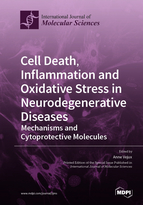Cell Death, Inflammation and Oxidative Stress in Neurodegenerative Diseases: Mechanisms and Cytoprotective Molecules
A special issue of International Journal of Molecular Sciences (ISSN 1422-0067). This special issue belongs to the section "Molecular Neurobiology".
Deadline for manuscript submissions: closed (31 October 2021) | Viewed by 50322
Special Issue Editor
Interests: oxysterols; very-long-chain fatty acids; lipid metabolism; diet, peroxisomes; biotherapies; inflammation; cancer; cell cycle and apoptosis; autophagy; biological membranes; oxidative damage; biomarkers; neurodegenerative diseases
Special Issues, Collections and Topics in MDPI journals
Special Issue Information
Dear Colleagues,
This Special Issue is the continuation of our previous special issue "Cell Death and Neurodegenerative Diseases: Mechanisms and Cytoprotective Molecules".
Neurodegenerative diseases represent a major societal challenge. These are not diseases with a short, life-threatening prognosis, but they are very debilitating, inflicting heavy demands on carers and requiring the establishment of appropriate centers for patient care. It is, therefore, important to know even more about the mechanisms involved in the physiopathogenesis of these diseases.
Neurodegenerative diseases include demyelinating neurodegenerative diseases: multiple sclerosis and peroxysomal and nondemyelinating leukodystrophies—Alzheimer’s disease, Parkinson’s disease, Niemann–Pick disease, Huntington’s disease and amyotrophic lateral sclerosis or Charcot disease. Among the mechanisms involved in these pathologies, inflammation, oxidative stress and cell death play very important roles in the pathophysiology. It is, therefore, important to better understand the involvement of cell death, inflammation and oxidative stress, as well as the cellular and molecular mechanisms leading to it, and to identify the natural or unnatural molecules that can thwart these mechanisms. Apoptosis, autophagy, necroptosis or other forms of cell death can be interesting therapeutic targets to combat the development of these neurodegenerative diseases. Cytokinic and non-cytokinic inflammation, as well as processes generating oxidative stress, could also be interesting targets to fight these pathologies.
Dr. Anne Vejux
Guest Editor
Note: You are warmly welcomed to submit your woks to our new edition: Cell Death, Inflammation and Oxidative Stress in Neurodegenerative Diseases: Mechanisms and Cytoprotective Molecules 2.0
Submission Deadline: 30 April 2022
Manuscript Submission Information
Manuscripts should be submitted online at www.mdpi.com by registering and logging in to this website. Once you are registered, click here to go to the submission form. Manuscripts can be submitted until the deadline. All submissions that pass pre-check are peer-reviewed. Accepted papers will be published continuously in the journal (as soon as accepted) and will be listed together on the special issue website. Research articles, review articles as well as short communications are invited. For planned papers, a title and short abstract (about 100 words) can be sent to the Editorial Office for announcement on this website.
Submitted manuscripts should not have been published previously, nor be under consideration for publication elsewhere (except conference proceedings papers). All manuscripts are thoroughly refereed through a single-blind peer-review process. A guide for authors and other relevant information for submission of manuscripts is available on the Instructions for Authors page. International Journal of Molecular Sciences is an international peer-reviewed open access semimonthly journal published by MDPI.
Please visit the Instructions for Authors page before submitting a manuscript. There is an Article Processing Charge (APC) for publication in this open access journal. For details about the APC please see here. Submitted papers should be well formatted and use good English. Authors may use MDPI's English editing service prior to publication or during author revisions.
Note: You are warmly welcomed to submit your woks to our new edition: Cell Death, Inflammation and Oxidative Stress in Neurodegenerative Diseases: Mechanisms and Cytoprotective Molecules 2.0
Submission Deadline: 30 April 2022







